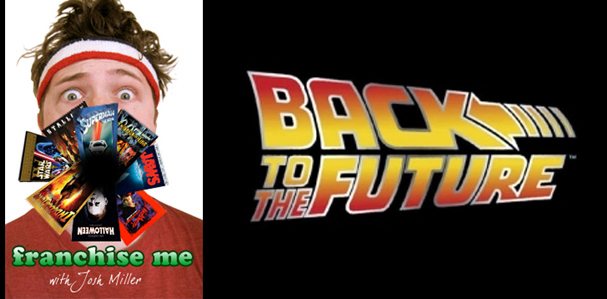
Hollywood loves a good franchise. The movie-going public does too. Horror, action, comedy, sci-fi, western, no genre is safe. And any film, no matter how seemingly stand-alone, conclusive, or inappropriate to sequel, could generate an expansive franchise. They are legion. We are surrounded. But a champion has risen from the rabble to defend us. Me. I have donned my sweats and taken up cinema’s gauntlet. Don’t try this at home. I am a professional.
Let’s be buddies on the Facebookz!
Buy my newest book!
The Franchise: Back to the Future: following the time-traveling adventures of teenager Marty McFly, eccentric inventor Dr. Emmett “Doc” Brown, and Brown’s creation, a 1981 DeLorean DMC-12 that has been modified into a time-machine. From 1985 to 1992, the franchise spanned three films and an animated television series.
previous installments
Back to the Future
Back to the Future II
The Installment: Back to the Future III (1990)
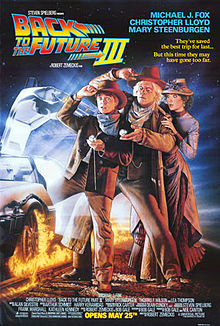
The Story:
So, Marty is stuck in 1955 once more, and just like last time he needs 1955’s Doc Brown to help him get the DeLorean working so he can get back to 1985. But wouldn’t ya know it? Just when everything seems like it is going according to plan, Marty and Doc discover that the elder Doc Brown gets murdered by an ancestor of Biff in 1885. So Marty heads back to the ‘Old West’ to save his buddy. But wouldn’t ya know it again? Indians attack Marty and the DeLorean rips a fuel line. Now Marty is trapped in 1885. Marty and the Doc need to devise a way to use a train to push the DeLorean up to 88 mph before Mad Dog Tannen kills either of them. Complicating matters further, Doc falls in love with a school teacher named Clara who is supposed to fall into a ravine and die or something. ZZ Top plays at a hoedown, and Flea from Red Hot Chili Peppers challenges Marty to a race.
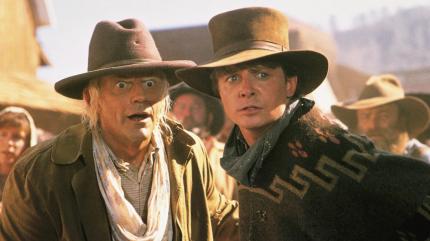
What Works:
Back to the Future III reminds me of Alien 3. As with the Ripley film, depending on your feelings regarding BTTF II (or Aliens), the third installment may strike you as either a refreshing “return to form” or a dull retread of the first film that completely fails to build on the franchise re-invention of the second installment. BTTF III is both, I think. But let’s focus on the positive first.
Regardless of your feelings on the respective sequels, it is hard to deny that BTTF III feels a lot more like a real sequel to Back to the Future than BTTF II did. II was going out of its way to be structurally different, whereas BTTF III comfortably recycles the basic beats and attitude of BTTF. More relevant though, II didn’t have a character driven story, it had a plot driven story — its charms lied largely in twisty storytelling pizzazz, callback gags, and FX exercises, which made it emotionally cold compared to the first film. II‘s stakes were broader and bigger. Marty was trying to undo an entire dystopic alternate timeline that affected millions of lives. In III, he is only trying to prevent Doc and himself from being murdered. I’m not saying one is any better than the other, but we must remember that Marty is a hero that was created for a story involving an intimate problem, not a broad one. Regardless though, despite the broader and bigger conflict in II, there was no ticking clock other than Marty and Doc’s desire to rectify the situation as soon as possible. After all, even if they failed to get the almanac from Young Biff before he made his first successful gamble, they had a functioning DeLorean. They could just keep traveling back in time again and again and again, Groundhog Day-style, until they got it right. III once again finds Marty trapped in the past due to a fuel-less DeLorean. That isn’t exactly a novel set-up, but it at least lends the film some immediacy. Like BTTF, this film employs oblivion as its ticking clock, only this time oblivion is coming in the form of Mad Dog Tannen’s bullet. It is even less novel to recycle a photograph as our visualizer for the ticking clock (Marty’s photo of Doc’s tombstone from 1955, which eventually changes to have Marty’s, or rather Clint Eastwood’s, name on it), but it does its job. Zemeckis isn’t forced to employ fake urgency by having Marty and Doc behave urgently.
Speaking on the subject of what our characters were originally designed for — Having just watched three films with the characters, I realized that I like 1955 Doc Brown (Young Doc) more than 1985 Doc Brown (Old Doc). Old Doc Brown is a sci-fi Gandalf. He knows everything and he scurries around getting Marty mixed up in shenanigans. Conversely, Marty is the one getting Young Doc mixed up in shenanigans. And Marty knows things that Young Doc doesn’t know, just by virtue of being from the future. So we get jokes like:
Doc: No wonder this circuit failed. It says “Made in Japan”.
Marty McFly: What do you mean, Doc? All the best stuff is made in Japan.
Doc: Unbelievable.
I like that Young Doc is a little doofier than Old Doc. When Old Doc is reunited with Marty he asks, “What idiot dressed you in that outfit?” And Marty replies, “You did.” Young Doc’s naivete, his sense of wonder, gives us a more rounded character. Which isn’t surprising. The character of Doc Brown was designed to be Young Doc. Old Doc only existed in the bookends of BTTF. In II, all we got was Old Doc, and this seemed to affect the tone and pacing of the film. Since Old Doc knows everything already, II dives head first into its story, almost too quickly. Whereas III continues to demonstrate that the franchise works best in 1955, where Marty is the one who has to motivate Young Doc. So I’m happy the Bobs allow themselves the luxury of farting around in 1955 with Marty and Young Doc for a while. I love the opening scene of this film, with Marty showing up at the clock tower seconds after Young Doc sent the original Marty back to 1985. I like Marty using the hoverboard as a foot rest. I like Doc getting excited about his relationship with Einstein, and being disappointed when Marty explains that is just the name of Old Doc’s dog. I like Doc accidentally leaning on his organ, providing his own dramatic music while he freaks out over Marty’s return to 1955. The scene of Young Doc reading Old Doc’s Western Union telegram aloud is possibly the most touching moment of the entire trilogy. All this said, III re-grounds Old Doc in a nice way, giving us something closer to what Old Doc must have been like on a day-to-day basis before the incident with the Libyans. So we’re getting a Doc we never actually got to see previously; the Doc with a routine. Doc is an inventor, yet in II he relied almost exclusively on items he acquired in 2015. In a sense, the film was telling us that while Old Doc was a genius in 1985, his abilities had been transcended by 2015 (aside from time travel). Futuristic gizmos are fun, but it is more fun – as least for the character of Doc – to force Doc to come up with zany creations of his own. Now in 1885 we get an automated breakfast-maker (which is a nice callback to the opening credits of BTTF), those uber-logs used to super-heat the train engine, not to mention Doc’s totally badass sniper rifle that I wish we had seen more of.
The romantic subplot between Doc and Clara (played fetchingly by Mary Steenburgen) is definitely the make or break element of III. If you can’t lock into it, the film isn’t left with much to offer other than stock Western riffs (though inserting Western veterans Pat Buttram and Dub Taylor into the film as bar patrons gets a thumbs up from me). Back in 1990, as a lad, I hated the romance. I felt like Marty in the film. Come on, Doc! Lose the chick, we have some serious shit going on here! Now, as an adult, the subplot works far more successfully on me. It is sweet and funny, and I realized I wanted it for Doc. Christopher Lloyd isn’t an actor who gets to play romantic very often, and that only helps his performance of an awkward lifelong bachelor suddenly presented with brand new lovey emotions. Though whole thing is very cute. And it is hardly Casablanca, but the moment when Doc realizes he has to let Clara go is a sad one, especially for this franchise. “Clara was one in a million. One in a billion. One in a googolplex!”
Thomas F. Wilson really lucked out in this trilogy. More than any of the other actors, Wilson has gotten to display the most diversity. And once again he delivers the goods. I tip my hat to him particularly for the shit-eating little celebration he does after Mad Dog thinks he’s killed Marty in their duel. So obnoxious and great.
Say what you will about the scale of the film (I’ll say it is small), III has a great climax. The unfinished bridge extending horrifyingly out into the ravine is yet another ticking clock, fitting for both the Western motif and the time-travel motif (since Marty and Doc are relying on the bridge to be built between 1885 and 1985). Most of the film’s Western homages are superficial, but Zemeckis shows up in directorial force for the train sequence. As just an action sequence it is delightful, with Fox doing enough of his own stunts to make things extra engrossing. But the sci-fi elements meld perfectly with everything else (some heartily inspired usage of this franchise’s potential). I mean, the three stages of propulsion that Doc’s uber-logs give them, letting us and the characters know exactly when the train will suddenly lurch forward with greater speed — that is the kind of making-it-look-easy dramatics that Zemeckis was king of during this stage of his career. Just the image of the DeLorean on rail wheels is great, giving us now our third period-version of the car. And having the hoverboard serve as the saving grace – with that shot of Doc holding Clara in his arms and floating off to safety – even got a big reaction from uncaring young Josh back in 1990. As did the destruction of the DeLorean. The fact that Doc wanted to destroy the DeLorean bugged the hell out of me as a kid. I related to Marty a lot in the films, so it was going to be a pretty big stretch for me to accept that Marty would actually follow through with Doc’s wishes and destroy the DeLorean. No way. But having a train completely destroy the car within moments of Marty arriving in 1985 is probably the best way to accomplish getting the DeLorean out of the picture. Just take the decision out of Marty’s hands. Then we have Doc showing up in the time-train to alleviate the crushing sense of dissatisfaction the destruction of the DeLorean brought about. Even if the Bobs were ending the franchise here and now, I still want to know that time-traveling adventures are taking place. Anything else would have been unacceptable to both child me and adult me.
Very minor, but I enjoyed the Bobs’ jab at their own propensity for employing forced time-crunches in this trilogy, when the Bartender informs Marty that it will take about ten minutes for the “wake up juice” to snap Doc out of his drunken coma. And Marty replies, “Ten minutes? Why do we have to cut these things so damn close?”

What Doesn’t Work:
II and III were shot back-to-back. While that scheme makes a lot of sense budgetarily, I don’t think it is a good idea, creatively, to complete a third installment before you even know what people like and don’t like about the second installment. Shooting a long film and chopping it into two pieces, like the final Harry Potter, is one thing. BTTF II and III are narratively inseparable, they do complete a single overall story. Yet they are very distinctively divided tonally, structurally, and stylistically. Frankly it is a creative choice I don’t entirely understand. I would understand wanting to just make two separate films, but they aren’t separate. III completes II‘s arc. Separating the story pieces so starkly wound up making II overly busy and low on emotional resonance, and left III without a hell of a lot to do (because II got all the fun and clever story shit). Why make II so epic? And III so contained? Why not weave the films together more? Create even more complications and paradoxes, and possibly wait to resolve the alternate timeline in III? That idea might not have worked at all, but it also might have allowed II to have more heart and III to have more scope and originality. It might have also given Marty more to do in III. I like seeing Doc do more than shuttling Marty around and saving Marty at the last second from things, but in III Marty often feels like a third wheel in his own franchise. Marty’s only real plot obligation is the duel with Mad Dog. Other than that he’s left to play the flustered straight man to Doc’s puppy love. Marty at times even becomes something of an antagonistic force, because he is trying to deny Doc happiness. It isn’t that this is bad writing and misuse of the characters, but in a tight trilogy that is very clearly closing the franchise down in this installment, the whole triangle feels like a stall being utilized because there isn’t enough going on. Hell, Marty getting into the duel with Mad Dog is only there because otherwise Marty would literally have nothing to do. Doc was going to get shot by Mad Dog, now Marty will. It is a redundant plot complication, considering that Marty was already risking his life to prevent Doc from being shot.
BTTF is a very cheery franchise. But up until now that cheeriness fit in with the time periods. Both the ’50s and ’80s were decades characterized by an upswing in consumerism and a false feeling that life was bitchin’ for everyone. The Bobs then made the funny choice to present a 2015 that continued down that rabbit hole. But ‘Old West’ 1885 wasn’t like that. I don’t know that Marty and Doc should have found themselves in McCabe and Mrs. Miller or something, but the clean and friendly version of III‘s ‘Old West’ feels very television to me — like The Adventures of Brisco County, Jr. It is entertaining to see Marty and Doc doing Westerny things, like pulling the DeLorean behind a band of horses, but there is no commentary or insight into the period like we saw in 1955 and even in the shrill hollowness of 2015. It is ‘dress-up’ cowboys and Indians, the Bobs giving themselves a chance to walk their franchise through all the basic conventions of the Western genre. In parts their affection is contagious, but overall it is hard to escape the fact that they’re intentionally painting inside the lines. It is the kind of ‘Old West’ you’d expect from an episode of Star Trek: The Next Generation, with the crew having some laughs in the holodeck, or a cartoon in which a character gets bonked on the head and fantasizes they’ve traveled through time.
Let’s talk a little bit more about the “Nobody calls me chicken” thing. As we talked about last time, the chicken trigger came out of no where to be Marty’s lone character flaw. It played no real part in II, but now it does. Now it serves as Marty’s character arc. As a one-note character flaw for a family comedy, the chicken thing isn’t terrible. It is kinda funny. It doesn’t feel like the Marty from BTTF, but a franchise has the right to tweak things as it moves along. But the flaw has no background or context in Marty’s past. Why is he like this? Worse though, the trait seems generally contradictory to Marty’s whole personality, as though the chicken thing had been programmed into Marty by a hypnotist at a party as a practical joke. Whenever Marty hears “chicken” or “you’re yella” it is like a scene from The Manchurian Candidate. He switches from Jekyll to Hyde. And all so the trilogy can have the cheap sense of sending Marty on a journey of personal discovery. The other problem here, for me at least, is that Marty’s “arc” is tied into his relationship with Jennifer — a character and relationship I care nothing about. In BTTF getting back to Jennifer is the least of Marty’s concerns. He barely even mentions it. In II, Jennifer is dumped from the story as soon as the Bobs could figure out a good way to do so. It is hard to get too worked up about Marty being reunited with Jennifer at the end of III. Partially, maybe, because after all this I want more for Marty than simply settling down with Jennifer, especially once Doc turns out to be a huge hypocrite and shows up in a fucking time-traveling train! How am I supposed to feel about Marty settling down at the age of seventeen, while, meanwhile, the Brown family is gallivanting around history without him? And on that topic…
What the hell, Doc Brown? Oh, destroy the DeLorean, we have to destroy the DeLorean, it is too dangerous to travel through time Marty, blah blah blah. But apparently what Doc really meant was, “I don’t trust YOU, Marty, with a time-machine.” Cause the moment Marty was out of the picture Doc decided to build a new one. Now he takes his two young sons through time? Two little boys?! I can’t think of a more potentially dangerous thing than what two small boys might do to the historical timeline as we know it. This isn’t actually a complaint about the film, because the time-train ending is petty neat. I’m just saying. Doc is full of shit! I’d be pissed if I was Marty. Furthermore, why wouldn’t Doc tell Marty about Marty’s future? No man should know too much about his own future, right? Sure. Though BTTF also ended with Doc having decided to ignore his own advice. And Marty twice has saved Doc from his destiny of getting shot. Twice! It is like Final Destination; the universe wants Doc shot dead. Yet Doc doesn’t want to prevent Marty from ruining his life? Thanks for having my back, bro.
The Bobs set a dubious precedent in II when Michael J. Fox played Marty’s two children, because now it would have been strange for Fox to not play another member of the McFly clan in III. But it just feels pointless here. I guess it is slightly amusing watching Fox goof his way through an Irish accent, but Seamus McFly doesn’t need to be in the film. The whole thing only reminded me of how tragically little Lea Thompson gets to do in the film. And how totally absent Crispin Glover sadly is.
I have more to say about III as an intentional franchise ender, but I will save that for the “franchise assessment” section of the next installment.
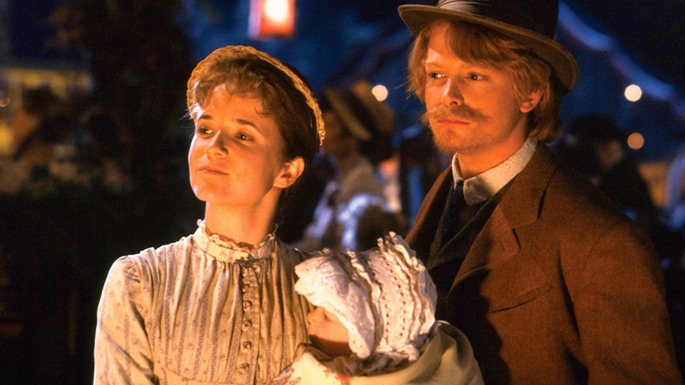
Best Biffism: “Eight o’clock Monday, runt. If you ain’t here, I’ll hunt you and shoot you down like a duck.”
Marty’s Best Contribution to History: He sort of invents Frisbee.
Marty’s Best Use of Future Superiority: Using his knowledge of A Fistful of Dollars, Marty both re-purposes Clint Eastwood’s name as an alias, and more crucially, takes inspiration from the film to create a bulletproof vest out of a stove door. Also, he uses the moon walk to distract Mad Dog.
Time Travel Murkiness: Wait a minute, so George McFly’s great-grandmother, living in 1885, looked exactly like…his wife, Lorraine? So…was Maggie McFly an ancestor of Lorraine’s? Meaning that George and Lorraine’s families coupled off twice in just a few generations without them knowing? Or is it just a crazy coincidence, or…I’m confused.
Most Rosy View of the Past: Not showing the citizens of Hill Valley displacing all those Indians aimlessly being chased by the US Cavalry.
How the Characters Could Have Better Used Time Travel: I don’t see why Doc had to say goodbye to Clara at all. Couldn’t Doc have gone to 1985, dropped Marty off, refueled the DeLorean, then gone back to 1885 and then either destroy the DeLorean and stay there or bring Clara back to 1985? How many times do I need to say this guys — You have a time machine!
Should There Be a Sequel: Yes. We still have a time machine.
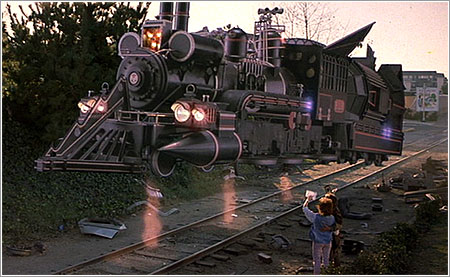
Up Next: Back to the Future (The Animated Series)
previous franchises battled
Alien
Critters
Death Wish
Hellraiser
Home Alone
Jurassic Park
Lethal Weapon
Leprechaun
Meatballs
The Muppets
Phantasm
Planet of the Apes
Police Academy
Predator
Psycho
Rambo
Tremors